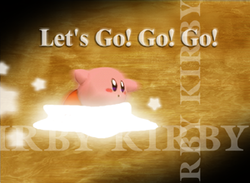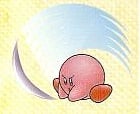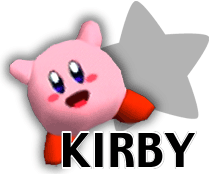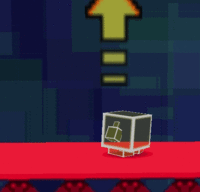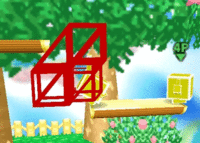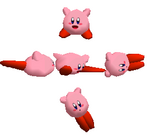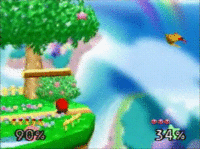Kirby (SSB)
| Kirby in Super Smash Bros. | |
|---|---|
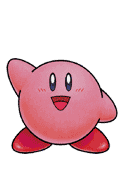 
| |
| Universe | Kirby |
| Other playable appearances | in Melee in Brawl in SSB4 in Ultimate |
| Availability | Starter |
| Tier | S (2) (North America) ? (2) (Japan) |
Kirby (カービィ, Kirby) is a starter character in Super Smash Bros. He is known for being a small, light character with quick and often surprisingly long ranged attacks, as well as surprisingly strong moves and a great recovery. He is voiced by Makiko Ōmoto, which would go on to keep voicing him in all subsequent video game appearances to date.
Kirby ranks 2nd on the current tier list and is his best tier placement in the series. Kirby has strong, fast attacks that can KO at damages below 100%, such as his forward smash, and he has a great edgeguarding game, due to his long recovery and powerful aerials, particularly his down aerial. Kirby also has several methods to space against opponents, with his back aerial and forward aerial having large disjointed hitboxes that have significant combo potential, and his up tilt is notably considered one of the best attacks in the game due to its large range, high speed, good combo ability, and ability to break shields.
However, Kirby's primary weakness consists of his recovery. Despite being long-distanced, he has few options for returning to the stage, creating a slow, linear recovery that can be easily intercepted. Furthermore, Kirby's combination of having a light weight and being rather floaty makes him vulnerable to juggling and vertical KOs. Kirby's combo game is also predictable against certain characters, being reliant on solely his up tilt and forward aerial on such characters, and these two attacks do not complement each other very well.
Regardless of these weaknesses, Kirby's strengths outweigh his weaknesses by a considerable margin, and he has had very strong tournament results alongside above-average representation.
Attributes
Kirby is a small, light, and somewhat floaty character. He is relatively difficult to combo horizontally and offstage, though is vulnerable to juggling and many vertical KO techniques (as well as not being too hard to KO horizontally either). His "signature move" is Swallow, which allows him to use an opponent's neutral special move and copy their appearance.
In general, Kirby possesses quick yet powerful moves. Some of his moves are infamous for possessing high range and being able to space well, most notably his up tilt (which covers the range of more than one Kirby both horizontally behind him and vertically), as well as his forward and back aerials. This makes a Kirby playing defensively correctly rather difficult to punish. However, Kirby's defensive ability is hindered slightly by his average to below average movement speed, with average dashing and walking speeds, low air speed, and below average falling speed. Kirby's smashes are powerful, especially his forward smash, which is by far the best forward smash in the game due to being the most powerful, having quick startup (though it has a bit of ending lag), and being an excellent punish or panic option. Kirby's throws are also fairly powerful, with his good grab allowing him to utilize them efficiently.
Kirby's up tilt and forward aerial are especially useful combo moves. The former can easily chain into itself at lower percentages and lead into aerials, a forward smash, or a up smash, while the latter is a great damage racker, being a very fast multi-hit move with the first few hits having set knockback, allowing them to lead into the final hit easily. The move can deal over 20% damage, and if the final hit isn't landed, it sets up a jab that can jab cancel into a grab to rack up further damage.
Kirby has an excellent recovery and offstage game. He has five midair jumps, and his Final Cutter not only extends his vertical recovery even more but allows Kirby to also move to the side while using it by tilting the control stick. While his recovery travels a spectacular distance (only rivaled by Pikachu's recovery), it is somewhat predictable, due to being on the slow side and Kirby's slow air speed. His aerials can be used to edgeguard or guard break easily, especially his down aerial, which is a strong meteor smash that can also drag opponents down at lower percentages. With Kirby's aforementioned excellent vertical recovery, it is also easy to recover from.
Kirby's main weaknesses are his light weight and floatiness, somewhat lack of reliable combo options outside the basic up tilt and forward aerial, and a lack of ways to KO onstage outside forward smash. He is additionally easy to juggle, being vulnerable to vertical combos from Fox, Captain Falcon, and others to a lesser extent.
Differences between game versions
Kirby was noticeably nerfed in his transition to NTSC-U. Despite his smaller size resulting on him being harder to hit (while not compromising his moves' huge range), a few of his moves deal less damage making them weaker. His recovery distance is shorter, due to Final Cutter covering less horizontal distance. Lastly, the higher presence of SDI makes Kirby's moves easier to escape, while the removal of momentum sliding hurts Kirby's approach, enforcing a slightly more defensive playstyle. Nevertheless, due to Kirby's immense strengths not being immensely toned down, he is still one of the most viable characters in the game despite the nerfs.
Attributes
 Kirby is smaller (0.94 → 0.91). This gives his attacks less range but also makes him harder to hit (granted he has not performed the bigger Kirby glitch).
Kirby is smaller (0.94 → 0.91). This gives his attacks less range but also makes him harder to hit (granted he has not performed the bigger Kirby glitch). Rolls are shorter (without the bigger Kirby glitch) due to Kirby's smaller size.
Rolls are shorter (without the bigger Kirby glitch) due to Kirby's smaller size. The removal of momentum sliding slightly hurts Kirby's approach.
The removal of momentum sliding slightly hurts Kirby's approach.
Ground moves
 Neutral attack's second hit now uses a weak punch sound instead of a medium punch sound.
Neutral attack's second hit now uses a weak punch sound instead of a medium punch sound. Neutral attack's loop hits launch opponents at a slightly lower angle (70° → 65°).
Neutral attack's loop hits launch opponents at a slightly lower angle (70° → 65°). Neutral attack's loop hits have smaller hitboxes (90u → 50u) and the far hitbox has been moved closer to Kirby (x offset: 200 → 165).
Neutral attack's loop hits have smaller hitboxes (90u → 50u) and the far hitbox has been moved closer to Kirby (x offset: 200 → 165). Up and down smash both deal 2% less damage (18% (up)/20% (down) → 16%/18%) and have decreased base knockback (24 (up)/40 (down) → 20/30).
Up and down smash both deal 2% less damage (18% (up)/20% (down) → 16%/18%) and have decreased base knockback (24 (up)/40 (down) → 20/30).
Aerial attacks
 Up aerial deals less damage on the clean and mid hits (12% clean/9% mid → 10%/8%).
Up aerial deals less damage on the clean and mid hits (12% clean/9% mid → 10%/8%). Up aerial has a smaller hitbox (150u → 105u).
Up aerial has a smaller hitbox (150u → 105u).
Throws
 Forward throw sends at a higher, more diagonal angle (45° → 70°), granting it vertical KO ability but hindering its horizontal KO potential and hindering its ability to set up edgeguards.
Forward throw sends at a higher, more diagonal angle (45° → 70°), granting it vertical KO ability but hindering its horizontal KO potential and hindering its ability to set up edgeguards. Forward throw has increased base knockback (80 → 100).
Forward throw has increased base knockback (80 → 100). Forward throw has gained a collateral hit when Kirby lands.
Forward throw has gained a collateral hit when Kirby lands. Kirby releases opponents from forward throw later (frame 56 → 58), decreasing its ending lag.
Kirby releases opponents from forward throw later (frame 56 → 58), decreasing its ending lag.
Special attacks
 Final Cutter covers less distance when used on the ground (without the bigger Kirby glitch) due to Kirby's smaller size.
Final Cutter covers less distance when used on the ground (without the bigger Kirby glitch) due to Kirby's smaller size. Stone deals 2% less damage (22% → 20%) and has decreased knockback scaling (78 → 70).
Stone deals 2% less damage (22% → 20%) and has decreased knockback scaling (78 → 70).
Moveset
For a gallery of Kirby's hitboxes, see here.
| Name | Damage | Description | ||
|---|---|---|---|---|
| Neutral attack | Vulcan Jab | 3% | Kirby performs two quick jabs, followed by a series of very fast, very weak punches. The first hit comes out on frame 3, making it Kirby's fastest ground move. The two jabs have short range, though the second has better range than most neutral attacks. The attack is based on the Vulcan Jab from the Fighter ability. The second hit can lead into a down tilt at higher percents. It is overall a situational move it Kirby's kit but it does have its uses.
The rapid jab has noticeably more range in the Japanese version although it is relatively useless in all versions, with Kirby players generally only doing the first one or two hits. | |
| 4% | ||||
| 1% per punch | ||||
| Forward tilt | ↗ | 11% | Kirby kicks forwards. It comes out quickly, is fairly safe and has deceptively long range (although its range is not too impressive compared to Kirby's other moves). Can be angled for a 1% change in damage either way although the move is not very strong overall and it generally lacks followups. The move is mainly used as a quick poke to keep opponents in front of Kirby out. It is a solid move overall but is Kirby's least effective tilt. | |
| → | 10% | |||
| ↘ | 9% | |||
| Up tilt | 14% (clean), 10% (late) | Kirby kicks vertically upwards, slightly behind himself. The move starts off hitting behind him with strong damage and vertical knockback and it later hits above him with weaker damage and knockback. The move comes out very quickly on frame 4, has minimal ending lag (only having 17 total frames), has deceptively long range both horizontally and vertically (far surpassing his foot) and it deals high damage and strong vertical knockback. The clean hit KOes Mario on Dream Land at 131% from ground level. All these factors combined make the move highly potent for a multitude of reasons in numerous scenarios.
The move's quick speed and great range make it excellent at stuffing out approaches. The move can easily punish opponents who recklessly approach and the move itself is very difficult (or even impossible in many scenarios) to punish due to its speed and range. Kirby can also approach with the move himself with pivot up tilts and the move is a very strong anti air due to its speed and range. The move also has excellent combo potential. The move has vertical knockback which launches opponents towards Kirby which along with the move's quick speed and long range allows it to easily chain into itself multiple times at lower percents and at higher percents, it can lead into Kirby's aerials. Against fast fallers especially, an up tilt at 0% can easily build up a lot of damage and it can even lead into a KO in one combo in certain scenarios. Even if an up tilt combo does not lead into a KO, it can still easily get the opponent off stage where Kirby has access to his strong edgeguarding tools. Kirby can also use his aerials to lead into an up tilt for a combo. Up tilt also has incredible shield pressuring potential. Its quick speed and high damage give Kirby a large frame advantage after hitting an opponent's shield, which gives him more than enough time to hit them with another up tilt, especially since it has a lot of range. Three up tilts into a forward smash or a back/neutral aerial into two up tilts in a forward smash are simple, guaranteed shield break combos Kirby has against most of the cast (assuming the up tilt is fresh although even a stale up tilt gives Kirby a solid frame advantage on shield). The only real downsides up tilt has are that it has limited range in front of Kirby and at higher percents (and before it becomes strong enough to KO), up tilt loses its combo potential, especially since Kirby has unspectacular vertical air mobility and no vertical juggling options in the air, which does decrease its potency at certain percent ranges. The move is still threatening at higher percents however due to its speed, damage and range and if the opponent crouch cancels the move at these higher percents, it can easily lead into a neutral or back aerial for a KO. Kirby's up tilt is overall considered to arguably be the best attack in the entire game due to its extremely fast speed, deceptively long range and its great damage racking and shield pressuring potential. The move is incredibly versatile, difficult to punish and rewarding to the point where Kirby simply having access to the move without using it can be threatening, since he can throw it out at any time with little risk. | ||
| Down tilt | 9% | Kirby performs a crouching kick. It comes out on frame 4, has incredible horizontal range and it sends opponents at a very low semi-spike angle, making it great for edgeguarding. It does have the highest ending lag and the least damage out of all of Kirby's tilts though, making it unsafe on shield when used at close range (although Kirby can easily space it to make it safe). The move is still highly solid however, due to its great range and edgeguarding potential. | ||
| Dash attack | 10% (clean), 8% (late) | Crashes into his opponents. This move is fast and can potentially be used as a followup, though it is often unsafe on shield and it often lacks followup potential. It can be used as a followup in some situations although Kirby generally has better options such as his grab. | ||
| Forward smash | Smash Kick | 17% (clean), 12% (late) | Kirby advances forward with a strong kick. This attack is based on the Spin Kick from the Fighter ability. The move starts off with a very powerful kick and as Kirby travels further, the move becomes weaker.
This is the fastest forward smash in the game, coming out on frame 10, in addition to having relatively low ending lag. When combined with its long, advancing range, this makes it very easy to land compared to other forward smashes. It is not only the fastest forward smash but it is also the strongest non-angled forward smash in the game (excluding Link's forward smash in the European version), KOing Mario at 86% at the center of Dream Land. Even the late hit has respectable power for a late hit smash attack although it does not KO anywhere near as early. Kirby can combo into forward smash at KO percents with his forward aerial or a single hit of his down aerial, giving him a safe and fairly reliable setup into the move. It is also useful to either break shields or to shield poke in a shield break combo, especially since up tilt can lead into a guaranteed forward smash on shield. The move also grants Kirby frame advantage on shield and with perfect spacing and timing, it even leads into an up tilt frame trap on shield against a majority of the cast (with the up tilt either hitting the shield or hitting the opponent depending on what they do out of shield, which can either lead into an up tilt combo or a shield break combo into a combo/KO depending on the outcome). However, it deals below average damage for a forward smash, has a considerably weaker late hit, cannot be angled, and it has high enough lag high enough for it to be punished quite easily on whiff. These weaknesses, however, do not significantly hinder the move, with its strengths far outweighing its weaknesses, especially compared to other forward smashes. Kirby's forward smash is overall considered to be the best in the game, due to being both the fastest and strongest forward smash in addition to being safe and having a generous hitbox. | |
| Up smash | 16% (clean), 18% (NTSC-J clean), 12% (late) | Kirby performs a bicycle kick, which is similar to Fox's but it comes out much slower and has weaker knockback. The move comes out on frame 14 which is very slow for an up smash and its knockback is slightly below average, KOing Mario at 95% on Dream Land at ground level. The move also has a weaker late hit which hits behind Kirby and has weak horizontal knockback. Its ending lag is also fairly high, with the move being unsafe on shield on close range. It can start combos at certain percents but Kirby is always better off using his up tilt as it is faster and weaker, making it much better for starting combos. Up smash serves its purpose as a hard hitting anti-air and it can KO earlier than forward smash in some situations (with Kirby being able to lead into it with a forward aerial or a single hit down aerial in some situations) but it is overall a situational smash attack, especially when considering the potency of Kirby's forward smash. The move can hit opponents on higher platforms (on Dream Land) if the bigger Kirby glitch is used, making it a move which notably benefits from the glitch.
Up smash is noticeably stronger in the Japanese version, dealing 2% more damage and KOing Mario 15% earlier. Kirby can also hit opponents on platforms above him without the bigger Kirby glitch, due to his larger default size. This overall makes up smash less situational in the Japanese version as there are more scenarios where it can KO earlier than forward smash, although forward smash is still the far superior move overall. | ||
| Down smash | 18% (clean), 20% (NTSC-J clean), 10% (late) | Kirby spins with his feet flat on the ground with a long hitbox duration (although the move does become a lot weaker after its first few active frames). It comes out on frame 7, making it Kirby's fastest smash attack and it is also his most damaging smash attack. The move sends opponents at a fairly low angle and it has deceptively long range (especially since Kirby's feet are intangible while he performs it). Its speed and range make it useful for beating cross ups and rolls and it can catch opponents in situations where forward smash might be too slow.
It is Kirby's weakest and laggiest Smash attack however, with the move being unsafe on shield and easily punishable on whiff. Down smash can be useful in the right scenarios but forward smash is the preferred option when it can be used and down tilt is often good enough for edgeguarding purposes. Down smash is much more powerful in the Japanese version, which makes it more rewarding and desirable but it is still Kirby's weakest smash attack in said version, with forward smash still being preferred in a majority of scenarios. | ||
| Neutral aerial | 15% (clean), 10% (late), 3% (landing) | Kirby sticks his right foot out. The move starts off with a very powerful hitbox but then becomes much weaker after its first four active frames. It comes out on frame 3, has a long hitbox duration and it has great power, being the second strongest neutral aerial in the game. It also has great range, with the move being noticeably disjointed, making it highly effective at edgeguarding opponents along with its strength and duration. At lower percents, it can combo into a variety of moves, including a forward smash and even an up tilt, while at higher percents, it is effective at getting opponents off stage. The late hit can lead into a variety of followups at quite a wide percent range. The move is useful in a variety of situations, including edgeguarding, KOing, escaping followups, punishing Out of Shield and starting combos/shield pressure. The move does have fairly high ending lag however, so it is not Kirby's safest aerial to use off stage.
The move does have a landing hit with set knockback (when not Z-canceled naturally) although this landing hit will rarely connect if the neutral aerial hits outside of very low percents and it makes the move unsafe on shield on a normal landing. The hitbox can potentially catch opponents trying to approach or recover although it is generally better to Z-cancel the move overall. Neutral aerial is overall a very strong aerial for Kirby, due to its speed, power and range. | ||
| Forward aerial | 2% (hits-1-7), 6% (hit 8), 20% (total), 3% (landing) | Kirby performs a drill kick with his feet in front of him. It acts like other drill kicks for its first seven hits, being a meteor smash with set knockback, although Kirby performs it horizontally rather than vertically. The move also has an 8th hit which deals stronger horizontal knockback. The move comes out on frame 8, has relatively low ending lag and it has large hitboxes which cover Kirby's entire body, in addition to reaching further than his feet. Kirby can use forward aerial as both a combo starter and a combo extender. The multi hits on their own can easily lead into a variety of followups at any percents, including an up tilt or a forward smash and they can potentially be used to edgeguard on their own due to being meteor smashes. Kirby can also combo into forward aerial with an up tilt, where Kirby can then drag the opponent downwards to lead into a forward smash. The final hit is more powerful and can potentially lead into a forward smash at KO percents (especially when stale), in addition to being useful to edgeguard.
The multi hits do grant frame advantage on shield with a soft Z-cancel landing, which can lead into an up tilt frame trap with a perfect landing, although it is Kirby's weakest aerial on shield. The final hit is more effective on shield however, reliably leading into an up tilt or other followups. Forward aerial can be avoided with SDI although its large hitboxes can make it awkward to SDI out of, and Kirby can mix up how many hits he want to land if he is near the ground. The move also has a landing hit with set knockback although the move has high landing lag, which makes the landing hit very unsafe if it does not hit, making the player want to Z-cancel the move almost every time. Forward aerial is overall another highly effective aerial for Kirby, due to its strong combo potential (even with the presence of SDI). | ||
| Back aerial | 16% (clean), 12% (late) | Kirby kicks behind him with both of his feet. It starts off dealing 16% and solid horizontal knockback during its first four frames and then it receives a weaker late hit which deals 12%.
Back aerial comes out very quickly on frame 6 and it has a long hitbox duration, lasting until frame 26. In addition to this, the move is disjointed (especially during its later frames) and it covers Kirby's entire body. It not only hits really far behind Kirby but it can also hit in front, above and below Kirby, allowing it to easily catch opponents regardless of their position relative to Kirby. This not only makes the move effective for edgeguarding (when combined with its solid power and Kirby's multiple jumps) but it is also a highly effective move to keep opponents out. Characters with short range such as the Mario Bros. can heavily struggle to get around Kirby's back aerial which shuts down their approach. The move also deals high damage and has good KO power. Its KO power is fairly average for a back aerial but it has the advantage of coming out faster than back aerials of equal power, which along with its range, makes it a very effective edgeguarding tool, especially when combined with Kirby's multitude of jumps. The move in general is one of Kirby's strongest edgeguarding tools as Kirby has multiple jumps to abuse the move off stage and its ending lag is fairly low, which makes the move fairly non committal to use off stage, as Kirby can use it numerous times without the risk of getting KOed. It is Kirby's most damaging aerial which makes it his strongest aerial on shield. An advancing back aerial can easily lead into an up tilt on shield, which can then lead into another up tilt into a forward smash for a shield break. If a landing back aerial connects at lower percents, it can easily lead into an up tilt, which can then lead into a highly damaging combo or even a KO. The late hit is considerably weaker but it can lead into followups at a wider percents range, with it even potentially leading into a forward smash for a KO at specific percent ranges. When combined with its speed and range, this makes back aerial a threatening spacing move. The only notable downside back aerial has is that it has high landing lag, which does makes it quite punishable on whiff if Kirby misses the Z-cancel. This can be nullified with Z-canceling however and the move is still safe on shield with a normal landing when fresh. As a sidenote, this is Kirby's only aerial without a landing hitbox. Back aerial is not only considered to be Kirby's best aerial overall but it is also considered to be one of Kirby's top two moves and it is even considered to be one of the best moves in the entire game. This is due to its speed, range, power, safety and strong synergy with Kirby's attributes and moveset which give the move a lot of utility as well as making it a very low risk very high reward move. The move is even considered to be so strong that it flat out invalidates certain characters, similar to his up tilt. | ||
| Up aerial | Twinkle Star | 10% (clean), 12% (NTSC-J clean), 8% (mid), 9% (NTSC-J mid), 6% (late), 3% (landing) | Kirby spins around. This move would be his neutral aerial in later Super Smash Bros. games. Has set knockback and extreme lag, easily making it Kirby's worst aerial and most likely his worst move overall. It can lead into some of Kirby's KO moves against certain characters although Kirby is still better off using his forward aerial for KO setups or his neutral/back aerials as raw KO moves. The late hit is uniquely active for the rest of the animation length. | |
| Down aerial | 3% (hits 1-10), 30% (total), 3% (landing) | Kirby performs a drill attack with his two feet below him. 3% per hit, up to 10 hits for a total of 30%. The move is a fast meteor smash, which can drag opponents down, as well as being easy for Kirby to recover from. Has higher knockback than other drill kicks, making it excellent at edgeguarding but it is not as reliable on stage due to this. Has great shield pressuring potential and is overall a very useful move. | ||
| Grab | — | |||
| Forward throw | Air Drop | 13% (throw), 7% (NTSC-U/PAL collateral) | Kirby jumps high in the air and brings the target with him, similar to Ninja Kirby's Air Drop in Kirby Super Star, and slams them down from an explosive drop. One of the few f-throws to launch foes upward. Has good knockback for a forward throw. Can be used as a sacrificial KO when used at the ledge. Sends the opponent to the side in the Japanese version. | |
| Back throw | 16% | Kirby performs a backward suplex, slamming the opponent behind him. Sends the foe upwards and behind Kirby at an angle. The attack is based on the Backdrop ability from Kirby's Adventure. One of the least effective back throws in the game in terms of KO potential due to its vertical launch angle however, this also makes it a rather effective option for setting up tech chases and generally granting Kirby stage control. | ||
| Forward roll Back roll |
— | — | ||
| Techs | — | — | ||
| Floor attack (front) Floor getups (front) |
6% | Kicks on both sides and gets up. | ||
| Floor attack (back) Floor getups (back) |
6% | Kicks on both sides and gets up. | ||
| Edge attack (fast) Edge getups (fast) |
4% | Flips whilst getting back on stage. | ||
| Edge attack (slow) Edge getups (slow) |
4% | Slowly picks himself up and slides forward, like his dash attack. | ||
| Neutral special | Swallow | 6% (swallow), 10% (spit), 17% (spit out characters to bystanders) | If Kirby inhales an opponent, he can either copy their ability (gains their neutral special move and a hat resembling them by pressing the B button; see here for a list of Copy Abilities) or spit the opponent out as a projectile by pressing the A button, dealing damage to bystanders. | |
| Up special | Final Cutter | 8% (ascent), 2% (descent), 6% (shockwave) | Kirby swings upward with his Final Cutter and falls down. The cutter can deal damage, and it also emits a shockwave when it lands. Used for recovery, along with Kirby's five midair jumps. Meteor smashes anyone below it with powerful set knockback. If an aerial up special is performed by Kirby, his original body size multiplier goes from 0.91 (0.94 in the Japanese version) and it becomes 1.0. This is known as the bigger Kirby glitch, which increases the range of his attacks although it makes him easier to hit and it makes his sacrificial KOes less reliable. | |
| Down special | Stone | 20%, 22% (NTSC-J) | Kirby transforms into a stone. If used in the air, it has a damaging hitbox and Kirby falls down until he reaches the ground. It has solid KO power, although it was much more powerful in the Japanese version. | |
On-screen appearance
- Crash-lands a Warp Star into the ground, the warp star explodes, and Kirby does multiple 360° flips backward and lands on his feet.
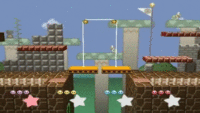
|
|---|
Taunt
- Turns to his right, puts his feet away and stands on tiptoes, inflates, looks up a little and says "Hi!" in a teasing manner while waving his arms three times in the air. If Kirby has an ability from an opponent while using this move, it gets discarded.
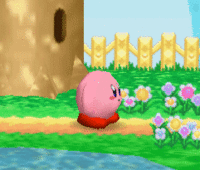
|
|---|
Crowd cheer
| English | Japanese | |
|---|---|---|
| Cheer | ||
| Description | Kir - by! *claps 3 times* | Kaa - *clap* bii! *clap* |
| Pitch | Group chant | Group chant |
Victory poses
- Does several handstands across screen.
- Slides and dances across screen (a reference to his end-of-level dances in Kirby's Adventure).
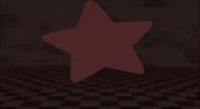 |
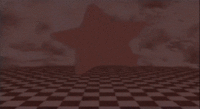
|
|---|
In competitive play
Most historically significant players
- See also: Category:Kirby professionals (SSB)
Numbers in brackets indicate position in 64 League Rankings 2017
DTan (#26) - Ranked 1st in Colorado.
Fukurou (#1) - Best player in the world in 2017, won Snosa III and SSC 2017 and some Japanese tournaments solo-maining Kirby.
HAMMERHEART - Currently the strongest solo Kirby main in the US.
HandsomeTom (#36 (2016)) - Known for popularizing the 3 up-tilts into f-smash combo on Falcon
Keisuke - Japan's fourth best Kirby (2017); 3rd at Kansai 2016, 5th at Autumn Kanto Tournament.
Kikoushi - 1st at Apex 2013, used to be the best Kirby in the world.
kysk (#7) - Best player in the world in 2019 triple maining Kirby, Pikachu & Captain Falcon, but most wellknown for his Kirby; 1st at GENESIS 6 and Super Smash Con 2019 and 1st at multiple Japanese nationals (Kansai 2017, Autumn Kanto Tournament, Kanto 2018).
Mew2King - Placed 1st at WHOBO 5, now focuses on other Smash games.
Moyashi - Japan's 3rd best Kirby, 2nd at Apex 2014, won some Japanese nationals (Kanto 2010, Kansai 2011).
Preston - 7th at Get On My Level 2018.
Revan (#24) - The best Canadian solo Kirby main.
Star King (#40)
Stradon - Used to solo main Kirby, switch to Pikachu recently, but still uses Kirby sometimes.
SuPeRbOoMfAn (#4) - The best North American Kirby player, more well-known for his Captain Falcon and Pikachu.
Tatsuman - Best Japanese player from 2006-2008, won some Japanese nationals.
Tier placement and history
Kirby has widely been considered a top tier throughout the entire competitive history of the Super Smash Bros., only rivaled by Pikachu for best fighter in the game. This placement is largely due to his above average recovery, quick yet powerful attacks with deceptive range, and being able to easily punish bad recoveries, which happens to be most of the roster. Likewise, he has seen excellent tournament representation and results since the beginning of Smash tournaments, including getting the most wins at Smash Bros. Fighting Battle: Smash Bros. Meijin Deciding Game in 1999. There was a brief period where Fox was considered better than Kirby, but that decision was quickly recinded and Fox now sits more comfortably in A tier while Kirby remains at S tier.
Techniques
Inhale Sacrificial KO
Kirby can use his Inhale move on opponents and fall to the map's bottom blast zone for a sacrificial KO. However, Kirby can "spit out" his opponent under the stage (particularly useful on Dream Land) and then recover. Yoshi is the only character who is practically guaranteed not to be able to recover from this.
Final Cutter spike
The Final Cutter can spike opponents on the way down during its initial frames (approximately until the same height from which the Final Cutter was initiated).
Kirby's Sliding Up B Glitch
Mainly affects only the Japanese version, there is also a glitch called Kirby's Sliding Up B done by Dashing, wait for the dash to finish which is about 14 frames, turning instantly, and then do an Up+B 20 frames after you decided to do so. This is similar to Teleporting but is harder and is generally limited to flashy play/TASing. This was discovered by DSGnoll, a Japanese smash 64 players. The video, as popularized by Jpheal, a well known TAS player. In the non-Japanese version, the milder version of the up b slide travels less further and is not as useful.
In Single Player
Kirby appears as an opponent in the seventh stage of Single Player mode. The stage takes place in Dream Land and pits the player against a Kirby team of 8 Kirbys. Each of the eight Kirbys sports a unique hat (with the exception of one, which will be normal Kirby or one of the four unlockable characters after they've been unlocked) corresponding to each of the eight starter characters in the game. Except for the average and unlockable character Kirbys, they all appear in the selection screen order of the respective character whose power they copied. Keeping this in mind, if the player manages to defeat them in the right order (Mario, DK, Link, Samus, Yoshi, Fox, Pikachu, regular/random unlockable), he will be awarded the 25,000-point bonus Kirby Ranks.
Description
From the Game
The 8-inch high Kirby hails from a distant, peaceful star. Like his simplistic appearance, he is an easily-understood character. True to his instincts, Kirby eats when he gets hungry and sleeps as soon as he grows tired. Nevertheless, Kirby remains a formidable opponent. In addition to his distinct flying and swallowing skills, he also has the ability to copy enemy attacks for ever-changing action.
Works:
- Kirby's Dream Land (GB)
- Kirby's Pinball Land (GB)
- Kirby Super Star (SNES) (Kirby's Fan Pak in the Australian PAL version; correctly spelled as "Fun" in the European version)
Alternate costumes

| ||||
Trivia
- Kirby's shield stance is similar to his block stance in Kirby Super Star. When it is done with Mirror Kirby, he uses the orb shield just like the shields in Smash Bros.
- When Kirby hits a wall, lands on the ground, or does certain moves, small stars are emitted, similar to how they look in the Kirby games, thus giving authenticity to his origin.
- Kirby shares many of his attack animations with Jigglypuff, such as the ducking animation, neutral aerial and tumbling animation.
- While other characters perform a victory pose when selected on the character selection screen in Smash 64, Kirby uses a unique animation for this, being the only character to do so. This pose would also be used for one of his taunts in Super Smash Bros. Brawl.
- In addition, Smash 64 Kirby is the only character in any Super Smash Bros. title to have only two victory poses, as opposed to three.
- Kirby is one of four characters to have a green costume exclusive to team battle, the others being Mario, Captain Falcon, and Donkey Kong.
- When Kirby gets hit by an electric attack, his frightened eyes can be seen.
| Fighters in Super Smash Bros. | |
|---|---|
| Fighters | Captain Falcon · Donkey Kong · Fox · Jigglypuff · Kirby · Link · Luigi · Mario · Ness · Pikachu · Samus · Yoshi |
|
| |
|---|---|
| Fighters | Kirby (SSB · SSBM · SSBB · SSB4 · SSBU) · Meta Knight (SSBB · SSB4 · SSBU) · King Dedede (SSBB · SSB4 · SSBU) |
| Assist Trophies | Knuckle Joe · Nightmare · Chef Kawasaki |
| Bosses | Giant Kirby · Marx |
| Stages | Dream Land · Fountain of Dreams · Green Greens · Halberd · Dream Land GB · The Great Cave Offensive |
| Items | Maxim Tomato · Star Rod · Parasol · Warp Star · Apple · Dragoon · Superspicy Curry · Bomber |
| Enemies | Bonkers · Bronto Burt · Gordo · Parasol Waddle Dee · Plasma Wisp · Shotzo · Tac · Waddle Dee · Waddle Doo |
| Other | Gourmet Race · Whispy Woods |
| Trophies, Stickers and Spirits | Trophies (SSBM · SSBB · SSB4) · Stickers · Spirits |
| Music | Brawl · SSB4 · Ultimate |
| Masterpieces | Kirby's Dream Land · Kirby's Adventure · Kirby Super Star |
